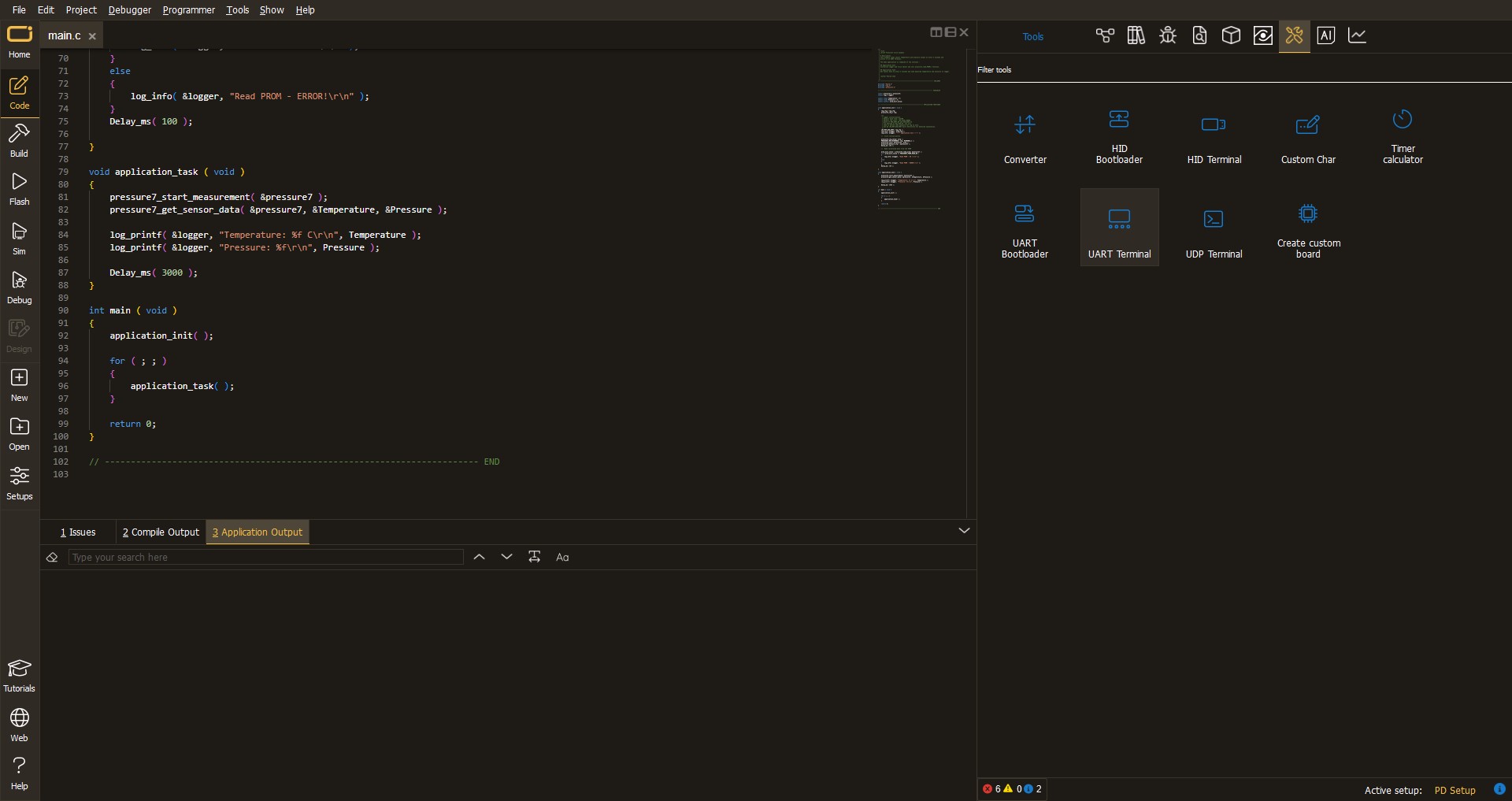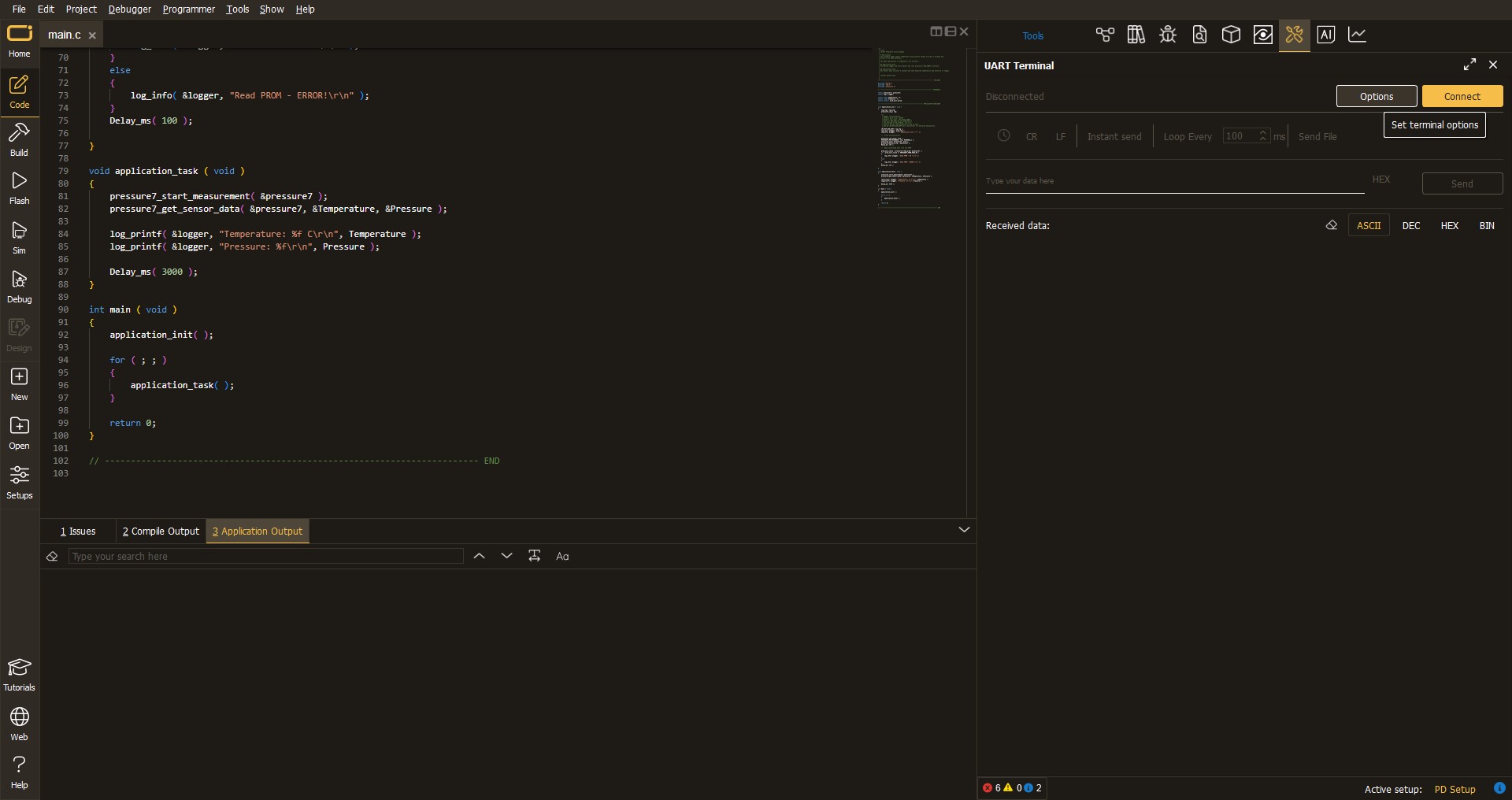Improve your motor control experience with our brushless driver, offering unparalleled smoothness, intelligent features, and superior performance for your every need.
A
A
Hardware Overview
How does it work?
Brushless 25 Click is based on the MCT8316A, a high-speed sensorless trapezoidal control integrated FET BLDC driver from Texas Instruments. It is the ideal solution for applications requiring the high-speed operation of up to 3kHz of electrical speed, a very fast startup time of under 50ms for 12V to 24V BLDC motors, and fast deceleration of under 150ms. The driver's control is highly configurable through register settings stored in an onboard non-volatile EEPROM. This feature allows the device to operate as a stand-alone device once it has been configured. In addition, the MCT8316A allows a high level of monitoring, where any variable in the algorithm can be observed as an analog output via two 12-bit DACs. Brushless 25 Click uses a standard I2C 2-Wire interface that allows the host MCU to configure EEPROM settings and read detailed fault and motor state information. If a fault condition occurs, the MCT8316A will pull the FLT pin to a low logic state, with a FAULT LED as a visual presentation. The FG pin is used as a motor speed indicator and provides pulses proportional to motor speed. For connecting the
three-phase BLDC motor, this Click board™ features the half-bridge output CBA screw terminal and a VM terminal for an external motor power supply. The RST pin can set the motor driver to sleep mode by turning all MOSFETs OFF. There are three switches to control the connected motor manually. The speed can be controlled by a PWM or analog value, which can be selected via the SPEED CTRL switch. The PWM signal can be set over the corresponding pin of the mikroBUS™ socket, while the analog value can be set over the MCP4161, an 8-bit, single SPI digital potentiometer with non-volatile memory from Microchip. The motor driver expects up to 95KHz of PWM frequency or an analog voltage in 732μV resolution. In addition, this is also a way to wake up the motor driver from sleep mode. The DIR switch changes the direction of the motor spinning with 0 and 1 positions. The low position (0) sets the phase driving sequence as ABC, while the high position (1) sets the ACB sequence. The I2C interface can overwrite this input. The Brake switch also has two states, with high entering the brake state. The MCT8316A will decrease the
output speed to the threshold value and stay in the brake state as long as this switch is in a high position. This input also can be overwritten by the I2C interface. In addition, the Brushless 25 Click comes with two headers above the mikroBUS™ socket for some optional feature additions. The VBK pin on the right-side unpopulated header is an output voltage pin from the internal buck regulator for some external loads. Other pins on this header are for monitoring algorithm variables and phase current feedback through DAC and SOX pins (the SOX pin can also be configured as one of the DAC pins). On the left is an unpopulated header with E_WD and E_CLK signals acting as the external clock reference and watchdog input pins. This Click board™ can be operated only with a 3.3V logic voltage level. The board must perform appropriate logic voltage level conversion before using MCUs with different logic levels. Also, it comes equipped with a library containing functions and an example code that can be used as a reference for further development.
Features overview
Development board
UNI-DS v8 is a development board specially designed for the needs of rapid development of embedded applications. It supports a wide range of microcontrollers, such as different STM32, Kinetis, TIVA, CEC, MSP, PIC, dsPIC, PIC32, and AVR MCUs regardless of their number of pins, and a broad set of unique functions, such as the first-ever embedded debugger/programmer over WiFi. The development board is well organized and designed so that the end-user has all the necessary elements, such as switches, buttons, indicators, connectors, and others, in one place. Thanks to innovative manufacturing technology, UNI-DS v8 provides a fluid and immersive working experience, allowing access anywhere and under any
circumstances at any time. Each part of the UNI-DS v8 development board contains the components necessary for the most efficient operation of the same board. An advanced integrated CODEGRIP programmer/debugger module offers many valuable programming/debugging options, including support for JTAG, SWD, and SWO Trace (Single Wire Output)), and seamless integration with the Mikroe software environment. Besides, it also includes a clean and regulated power supply module for the development board. It can use a wide range of external power sources, including a battery, an external 12V power supply, and a power source via the USB Type-C (USB-C) connector. Communication options such as USB-UART, USB
HOST/DEVICE, CAN (on the MCU card, if supported), and Ethernet is also included. In addition, it also has the well-established mikroBUS™ standard, a standardized socket for the MCU card (SiBRAIN standard), and two display options for the TFT board line of products and character-based LCD. UNI-DS v8 is an integral part of the Mikroe ecosystem for rapid development. Natively supported by Mikroe software tools, it covers many aspects of prototyping and development thanks to a considerable number of different Click boards™ (over a thousand boards), the number of which is growing every day.
Microcontroller Overview
MCU Card / MCU

Type
8th Generation
Architecture
ARM Cortex-M4
MCU Memory (KB)
2048
Silicon Vendor
STMicroelectronics
Pin count
216
RAM (Bytes)
262144
You complete me!
Accessories
Brushless DC (BLDC) Motor with a Hall sensor represents a high-performance motor from the 42BLF motor series. This motor, wired in a star configuration, boasts a Hall Effect angle of 120°, ensuring precise and reliable performance. With a compact motor length of 47mm and a lightweight design tipping the scales at just 0.29kg, this BLDC motor is engineered to meet your needs. Operating flawlessly at a voltage rating of 24VDC and a speed range of 4000 ± 10% RPM, this motor offers consistent and dependable power. It excels in a normal operational temperature range from -20 to +50°C, maintaining efficiency with a rated current of 1.9A. Also, this product seamlessly integrates with all Brushless Click boards™ and those that require BLDC motors with Hall sensors.
Used MCU Pins
mikroBUS™ mapper
Take a closer look
Schematic

Step by step
Project assembly
Track your results in real time
Application Output
After pressing the "FLASH" button on the left-side panel, it is necessary to open the UART terminal to display the achieved results. By clicking on the Tools icon in the right-hand panel, multiple different functions are displayed, among which is the UART Terminal. Click on the offered "UART Terminal" icon.

Once the UART terminal is opened, the window takes on a new form. At the top of the tab are two buttons, one for adjusting the parameters of the UART terminal and the other for connecting the UART terminal. The tab's lower part is reserved for displaying the achieved results. Before connecting, the terminal has a Disconnected status, indicating that the terminal is not yet active. Before connecting, it is necessary to check the set parameters of the UART terminal. Click on the "OPTIONS" button.

In the newly opened UART Terminal Options field, we check if the terminal settings are correct, such as the set port and the Baud rate of UART communication. If the data is not displayed properly, it is possible that the Baud rate value is not set correctly and needs to be adjusted to 115200. If all the parameters are set correctly, click on "CONFIGURE".

The next step is to click on the "CONNECT" button, after which the terminal status changes from Disconnected to Connected in green, and the data is displayed in the Received data field.

Software Support
Library Description
This library contains API for Brushless 25 Click driver.
Key functions:
brushless25_register_write- Brushless 25 data writing function.brushless25_register_read- Brushless 25 data reading function.brushless25_set_speed_value- Brushless 25 set speed function.
Open Source
Code example
This example can be found in NECTO Studio. Feel free to download the code, or you can copy the code below.
/*!
* @file main.c
* @brief Brushless 25 Click example
*
* # Description
* Application example shows the device's capability of controlling
* the brushless motor speed and state of the driver.
*
* The demo application is composed of two sections :
*
* ## Application Init
* Initializes the driver, sets the device into slow start mode
* and sets the speed of the motor to 30%.
*
* ## Application Task
* This example is taking track of the state of the driver and motor, as well as its
* voltage and speed which is changing from 30% to 100%, and logging it onto the USB UART terminal.
*
* @author Stefan Ilic
*
*/
#include "board.h"
#include "log.h"
#include "brushless25.h"
static brushless25_t brushless25;
static log_t logger;
uint8_t sw_data = 0;
uint8_t speed_val = 3;
void application_init ( void )
{
log_cfg_t log_cfg; /**< Logger config object. */
brushless25_cfg_t brushless25_cfg; /**< Click config object. */
/**
* Logger initialization.
* Default baud rate: 115200
* Default log level: LOG_LEVEL_DEBUG
* @note If USB_UART_RX and USB_UART_TX
* are defined as HAL_PIN_NC, you will
* need to define them manually for log to work.
* See @b LOG_MAP_USB_UART macro definition for detailed explanation.
*/
LOG_MAP_USB_UART( log_cfg );
log_init( &logger, &log_cfg );
log_info( &logger, " Application Init " );
// Click initialization.
brushless25_cfg_setup( &brushless25_cfg );
BRUSHLESS25_MAP_MIKROBUS( brushless25_cfg, MIKROBUS_1 );
err_t init_flag = brushless25_init( &brushless25, &brushless25_cfg );
if ( ( I2C_MASTER_ERROR == init_flag ) || ( SPI_MASTER_ERROR == init_flag ) )
{
log_error( &logger, " Communication init." );
for ( ; ; );
}
if ( BRUSHLESS25_ERROR == brushless25_default_cfg ( &brushless25 ) )
{
log_error( &logger, " Default configuration." );
for ( ; ; );
}
brushless25_set_speed_value( &brushless25, ( speed_val * 10 ) );
log_info( &logger, " Application Task " );
}
void application_task ( void )
{
uint32_t tmp_data = 0;
uint16_t spd_data = 0;
uint16_t voltage_data = 0;
brushless25_register_read( &brushless25, BRUSHLESS25_REG_SYS_STATUS2, &tmp_data );
tmp_data &= BRUSHLESS25_STATE_MASK;
switch ( tmp_data )
{
case BRUSHLESS25_STATE_SYSTEM_IDLE:
{
log_info( &logger, " System is idle " );
break;
}
case BRUSHLESS25_STATE_MOTOR_START:
{
log_info( &logger, " Motor is starting " );
break;
}
case BRUSHLESS25_STATE_MOTOR_RUN:
{
log_info( &logger, " Motor is running" );
if ( ( speed_val < 10 ) && ( sw_data == 0 ) )
{
speed_val++;
if ( speed_val == 10 )
{
sw_data = 1;
}
}
else if ( ( speed_val > 3 ) && ( sw_data == 1 ) )
{
speed_val--;
if ( speed_val == 3 )
{
sw_data = 0;
}
}
break;
}
case BRUSHLESS25_STATE_MOTOR_ALIGN:
{
log_info( &logger, " Motor is aligning " );
break;
}
case BRUSHLESS25_STATE_MOTOR_IDLE:
{
log_info( &logger, " Motor is in idle mode " );
break;
}
case BRUSHLESS25_STATE_MOTOR_STOP:
{
log_info( &logger, " Motor is stoped " );
brushless25_set_brake_state( &brushless25, BRUSHLESS25_BRAKE_ON );
break;
}
case BRUSHLESS25_STATE_FAULT:
{
log_error( &logger, " Fault accured " );
brushless25_set_brake_state( &brushless25, BRUSHLESS25_BRAKE_ON );
for ( ; ; );
}
case BRUSHLESS25_STATE_MOTOR_BRAKE:
{
log_info( &logger, " Motor brake is on " );
brushless25_set_brake_state( &brushless25, BRUSHLESS25_BRAKE_OFF );
break;
}
default:
{
break;
}
}
brushless25_set_speed_value( &brushless25, ( speed_val * 10 ) );
Delay_ms ( 1000 );
brushless25_register_read( &brushless25, BRUSHLESS25_REG_SYS_STATUS2, &tmp_data );
spd_data = ( uint16_t ) tmp_data / 10;
brushless25_register_read( &brushless25, BRUSHLESS25_REG_SYS_STATUS1, &tmp_data );
voltage_data = ( ( uint16_t ) ( tmp_data >> 16 ) / 10 );
log_printf( &logger, " Motor speed: %d Hz \r\n", spd_data );
log_printf( &logger, " Motor voltage: %d V \r\n", voltage_data );
log_printf( &logger, " --------------------- \r\n" );
Delay_ms ( 1000 );
}
void main ( void )
{
application_init( );
for ( ; ; )
{
application_task( );
}
}
// ------------------------------------------------------------------------ END


































